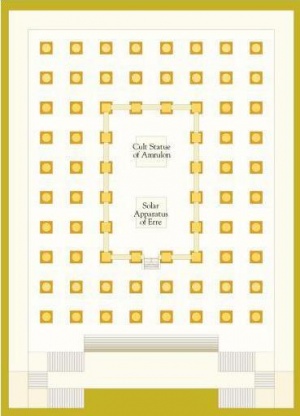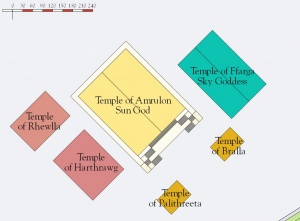Temple of Amrulon Sun God (Amyrn)
The staggeringly colossal edifice built over centuries beginning before the rule of the Yophenthean Empire and completed in the late Yophenthean Empire, the Temple of Amrulon Sun God has been sacked, crumbled by earthquake, and used a palace for chaos cults, yet its devoted worshipers always restored it to its esteemed dignity. Situated on the high hill of the capital city Amyrn, the temple serves as the seat of devotion to the Lord of Isxinthions and a gathering place for the theocrats who rule the city and the nation of Ambrasia.
Temple Dimensions
The Temple is octostyle with columns measuring 7.5 feet wide (2.286 m), not including the plinth. The reach of the entablature across the face is 202 feet (61.57 m). The span between the center of one column to the next is 24.5 feet (7.46 m). There are eight columns across the front and ten columns across the length. Each column reaches 75 feet high (22.86 m).
The ascent to the base of the columns rises twenty four feet (7.3 m), climbing up six stairways, three on either side up to a final common stairway in the middle for a total of forty eight steps.
A series of four long steps leads to the double doors of the inner sanctum of the god, each being six feet wide each, for a total of twelve feet across. Each door is about 36 feet high.
The sanctum of the temple is about the span of five columns in length and three columns in width. In the forecourt of the inner sanctum rests the relatively low Apparatus of Eriu, a solar observing device sacred to the goddess Eriu. In the aftcourt of the inner sanctum rests the cult statue of Amrulon Sun God, the square base of which is about twenty five by twenty five feet (7.5 m x 7.5 m).
History of Temple
The Temple was vowed in 312 by the chief of the Thiagona Tribe. At this time, the construction technology of the Moigthe consisted of simple stone and wood. The site was chosen to displace a more ancient Tuadbe (Neptulchi) temple to the sun who had in turned built a temple on an even more ancient Kemerite site to solar divinities. The Moigthe successor to the Neptultchi temple became revered among the Moigthe tribes over the centuries until around 425 when a new temple was vowed and built. The new temple employed construction methods learned from the Midretassenes who ruled Dúrandwor. After the Yophenthean conquest, the temple to the Lord of Isxinthions maintained its cult grandeur in the face of the spread of the Arathracian Religion. The Yophenthean rulers honored the Temple, acknowledging the patron god as the father of Arathrax. In the 700′s, the Diocesan Lord of Yophenthean Pytharnia vowed to reconstruct the Temple and this renovated form is the basis of the modern-day, octostyle temple. The temple cult persisted after the fall of the Yophenthean Empire into the 900′s. In 1032, an earthquake shook the temple, damaging it greatly, but not toppling any of the columns. The local leaders managed to repair it through increased taxes. In 2207, a great earthquake struck Amyrn and many of the columns were toppled. The damage was too great for the local rulers to summon the resources to restore it, although the cult statue was largely unharmed. The priests of Amrulon continued to officiate at the damaged temple into the Middle Ages of Chaos. Chaos Wizards, claiming to be subjects of Bexaloth, Archmage of Bryndyd, moved into the temple, displacing the ancient temple priests. Llamgathsukba of the Beasts defiled the site of the temple with this chaos cult practices in the twenty fourth century. The Isbajath of Sulmayand the Valiant brought about the demise of Llamgathsukba and his chaos priest minions. In the 2500′s the Emperor of Medibgö vowed to restore the temple to its ancient grandeur. A small but general tax throughout the Medibgóëse Empire funded the restoration of the ancient columns and repair of the overall structure. Additionally, the roof tiles and the column capitals were guilded with gold taken from the treasury of Kualotha of the Groaning Earth. This restored temple is more or less what visitors to Amyrn today behold when they climb the acropolis.
See Also
| This article is a stub. It requires further development by the creator. |

